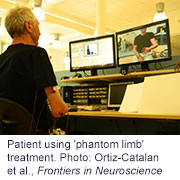
TUESDAY, Feb. 25, 2014 (HealthDay News) — A unique way to possibly treat the intense pain of phantom limb syndrome has been invented — by creating a virtual world for an amputee to enter via computer.
Within that world, the patient controlled a “virtual arm” and apparently relieved his pain by tricking his brain into thinking his body was whole again, according to a new report.
It’s not clear if the virtual treatment will reduce pain in anyone else who suffers from the mysterious phantom limb condition, and no one knows if the effects are permanent. The cost isn’t known, either.
For now, however, the treatment has made a big difference in the life of the patient, who suffered from phantom limb pain for decades, the researchers said.
“Pain stopped being a big part of his life,” said study author Max Ortiz-Catalan, a graduate student in the division of biomedical engineering at Sweden’s Chalmers University of Technology. “He does not wake up at night due to pain any more, and he can do physical activities more intensively without being affected by pain.”
Phantom limb pain appears in patients who have had limbs amputated but still “perceive” their missing limb, said Tamar Makin, a postdoctoral research fellow at England’s University of Oxford who studies the brains of amputees. “This ‘phantom’ sensation often manifests as unpleasant or painful, and has been estimated to occur in up to 80 percent of amputees, and therefore poses a significant medical problem,” she said.
Patients may feel sensations of burning or pressure as though their limb is being squashed, she said. Scientists now believe the pain has something to do with the way the brain looks at the body, Makin said, but a full explanation is still elusive.
Pain medications often fail to provide relief, she said. But a newer generation of treatments is trying to avoid medication by seeking to adjust the way the brain “sees” the body.
In the new approach, researchers created a virtual world onscreen that shows a representation of the amputee, a 72-year-old man who lost his right arm below the elbow in 1965 in a traumatic injury. On the computer screen, the man has a complete arm.
Sensors on the man’s arm stump allow him to control the virtual arm on screen. “He can see himself as in a mirror, with the difference that we are adding a virtual arm over his stump so he can see himself entirely again,” Ortiz-Catalan explained. “He is able to control the motion of that virtual arm as he used to control his missing arm.”
In addition, the man can play games on the screen by using the virtual arm. “The idea behind this is that he continues to use those brain areas that used to be responsible for the motion in the missing limb,” Ortiz-Catalan said.
Before the treatment, the patient reported always feeling low levels of pain from his phantom limb, with the pain spiking to the highest level every hour or so for a few minutes. After the treatment, the patient said he felt a significant reduction in pain.
“The reduction in pain has been steady, and he has been provided with a system to use at home,” Ortiz-Catalan said. “The treatment hasn’t been interrupted for more than a couple of months, in which no relapse has been observed.”
The next step: Researchers will soon start a clinical trial to study whether the treatment will work on other patients.
Makin, the Oxford researcher, called the research potentially promising, but cautioned that it still needs more study. For one thing, researchers need to make sure the pain relief isn’t from a placebo effect, she said. They also need to figure out if the treatment itself did the trick or if something else — like focusing attention or moving muscles — explains the relief.
Either way, she said, “the present research provides a good starting point for future research.”
The study appears in the February issue of the journal Frontiers in Neuroscience.
More information
For more about phantom limb syndrome, try New York University.
Copyright © 2025 HealthDay. All rights reserved.

